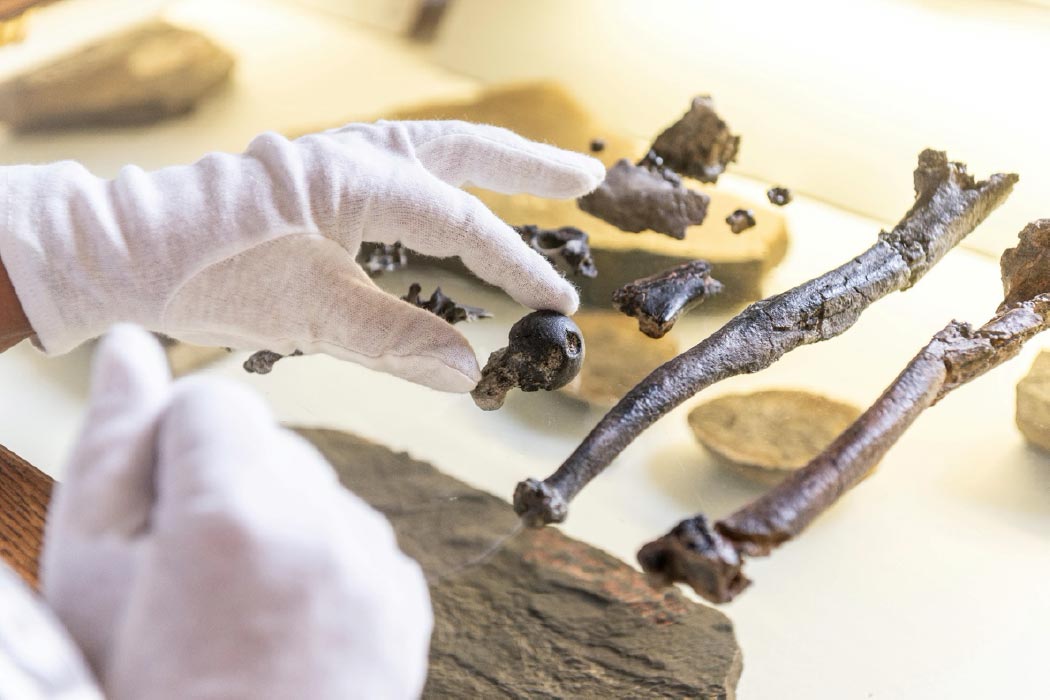Evidence Suggests Human Ancestor Walked Upright In Trees
Scientists have described an 11.62 million-year-old ape that moved like no other creature on Earth using its human legs and orangutan arms.
A team of scientists from Eberhard Karls University of Tübingen in Germany have presented a new paper about a species of fossilized ape found in Bavaria dating to 11.6 million years ago. Equipped with human-like legs and ape-like arms, it is said to have “clambered” across branches fleeing tree climbing feline predators. And it’s one of us!
Is Polygyny Genetic?
The scientists’ findings are published in the Nov. 7 issue of the journal Nature and perhaps the most interesting and important discovery is the creatures “weird locomotion”, if fact, the weirdest mover and shaker ever seen until now, which informed the researchers that this early human ancestor may have evolved to walk on two legs.
The 11.62-million-year-old Danuvius was discovered in a layer of clay in the municipality of Pforzen in the Swabian district of Ostallgäu and between 2015 to 2018 paleontologists made 37 individual finds of fully preserved arm and leg bones, vertebrae, finger and toe bones which showed similarities to how we move today.
The new study’s lead author, Madelaine Böhme, a paleontologist at the Eberhard Karls University of Tübingen in Germany, described Danuvius as weighing between 37 and 68 lbs. (17 and 31 kilograms) and the researchers found males were larger than females, suggesting polygyny, where the males mated with multiple female mates, according to the paper.

The 21 bones of the most complete partial skeleton of a male Danuvius. (Christoph Jäckle/ Nature)
Rethinking Our Ancient Origins
Since the 1970s many different fossils of ancient ape species have been discovered in both Europe and Africa and based on the available evidence all previous research had “assumed” humans had evolved from a four-legged creature using its palms or soles on the ground as they walked or suspended their bodies from trees, similarly to modern chimpanzees, in the middle to late Miocene epoch about 13 million to 5.3 million years ago.
From this “assumption”, it was believed ape and human lineages began diverging at this time, but this conclusion was based on fossils without intact limb bones which greatly restricted what researchers could deduce regarding our early ancestors’ locomotive habits, movement abilities and restrictions. This, according to a June 2016 Live Science article, was an “assumption” upon which a whole paradigm of research had been built.
Essentially, the new findings further paint the picture on how ancestors of modern great apes evolved to use their arms for movement which according to a report on Live Science is a “key trait” which distinguishes humans from modern great apes including chimpanzees, bonobos, gorillas and orangutans - our closest living relatives. And it is our bipedal posture; upright stance and ability to hold balance and walk on our feet that freed up our hands for tool production, a trait that could arguably be said to have “caused” or created us, as we are today.
- Early Humans Evolved in Ecosystems Unlike Any Found Today
- New Shocking Clues Into Human Origins From Qesem Cave
- Ancient Reptilian Hand Muscles Found in Human Embryos
Scampering Made Us What We Are
Unlike us humans, chimpanzees, bonobos and gorillas walk on their knuckles and orangutans on their closed fists, and they are all able to swing effortlessly between trees using their arms in a locomotion method known formally as brachiation. But now, Böhme and her colleagues suggest the “new type of locomotion”, which they dubbed “extended limb clambering,” may be the ancestral form of movement for both modern great apes and humans.
Madelaine Böhme told Live Science that the new species has been named Danuvius guggenmosi. The “Danuvius” part of the name is taken from the Celtic-Roman river god Danuvius and the word “guggenmosi” nods to paleontologist Sigulf Guggenmos, who discovered the site where the fossil was found.
When Danuvius lived, the area was a hot flat landscape with rivers and forests from the edges of the Alps, and belonged to a species called dryopithecines which are ancestors of modern African apes.
The creature’s thick teeth enamel suggests Danuvius ate hard items and the scientists also noted its “slightly elongated” arms compared to other fossil specimens suggesting it hung from trees like is seen in modern great apes and used its arms and legs about equally, the researchers said.
Attempting to answer “why" Danuvius didn't favor either its arms or legs the scientists say perhaps, Danuvius used its long, strong and opposable big toes to “clamber quickly along tree limbs to escape larger cats”.
The full report is published in Nature DOI: 10.1038/s41586-019-1731-0
Top image: Bones from the hand of a male human ancestor Danuvius guggenmosi. Source: Christoph Jäckle / Nature
By Ashley Cowie


















Comments
Anatomically, in consideration of our long fingernails and straight flowing hair, human ancestors almost certainly went directly from the water to the trees, bypassing flat ground living. The long fingernails would work well for plucking fruits, fish and crabs, as well as defense, and the long hair for concealment.